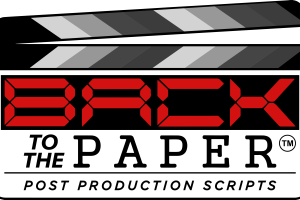In 2020, the film industry generated about $25.9 billion. That’s a lot of money, but making the larger chunk of this change is more than about raw filmmaking talent. It’s about preparing your film for distribution, a process involving a dialogue list.
What is a Dialogue List?
A dialogue list is a time-coded post-production script that is created after the film is completely ready to be delivered. Frame precise time codes are marked at the beginning and end of when sound or dialogue occurs in a movie. It would be submitted to television or cable networks or film distributors as part of the distribution package for the film. Dialogue lists are commonly used in translation to assist translators in creating a spotting list (subtitle file) for foreign languages.
What It Looks Like
There isn’t one perfect dialogue list format. But generally, the dialogue lists will ask for the following information: timecode in and out, duration, character name, and dialogue text. Some templates incorporate other features to specify dialogue in greater detail. But generally, these are the essential pieces of information included in nearly every dialogue list template. Dialogue lists also include lyrics, music descriptions, on-screen signs, vocal sounds, and more. Dialogue lists are typically formatted and downloaded in Microsoft Word .docx format. However, many dialogue lists are also generated as PDF and XLS files.
Other List Types
Post-production scripts differ from original screenplays in function, content, and script format. Other popular post-production scripts sent to production and network companies include As-Broadcast Scripts (ABS), Combined Dialogue and Spotting List (CDSL), and Combined Continuity and Spotting List (CCSL).
The Benefits
So, why should you bother with making a dialogue list? And how can a template get you ready for distribution? For starters, there are many ways to improve the accessibility of the film-viewing experience. Creating dialogue lists for your movies is just one of them, but it’s a significant step. Subtitlers use these dialogue lists to create closed captioning on screen. Another benefit? It saves time. Doing dialogue lists yourself strikes a happy medium between efficacy and peace of mind for those in charge of film production. Other benefits of creating and using a dialogue list are that it can typically cut down on translation costs, it can improve overall quality control of the production, and offer globalization/streaming opportunities!
Creating Great Lists
Creating an excellent dialogue list doesn’t have to be a daunting task. But for those who aren’t sure how to get started, we’ve got a few tips on writing an effective dialogue list.
Verbatim or not: First, decide if the dialogue list needs to be verbatim or not. By verbatim we mean should every sound be transcribed? Including false starts, mumbles, and stutters. While having a verbatim dialogue list can be very helpful, in fact, it is critical, for dubbing purposes, it can actually be detrimental for subtitles.
Duration of the dialogue: This will be tricky for you if you are creating a dialogue list yourself. We manually capture the in and out time codes using our captioning software and the duration is just simply calculated by the software. Having accurate duration is also critical for dubbing.
Accurate description of sound effects: Another tip? Make sure you specify the details for all the sound effects. The descriptions must be specific enough to properly immerse viewers who aren’t listening to the movie but just seeing it in their minds by only reading the dialogue exchange between characters. Remember: it’s not about making your prose look pretty. It’s about correctly communicating the aesthetic events of your movie to your film’s audience.
And finally, we encourage you to not just double or even triple-check for errors. but to quadruple-check. This will save you a ton of time and free you from frustration when everything reaches distribution.
At Back to the Paper, we understand the importance of a film reaching a broad audience. That’s why we offer plenty of professional, sleek dialogue list templates! Check them out today. And if you enjoyed the video, then be sure to like, comment, and subscribe!


